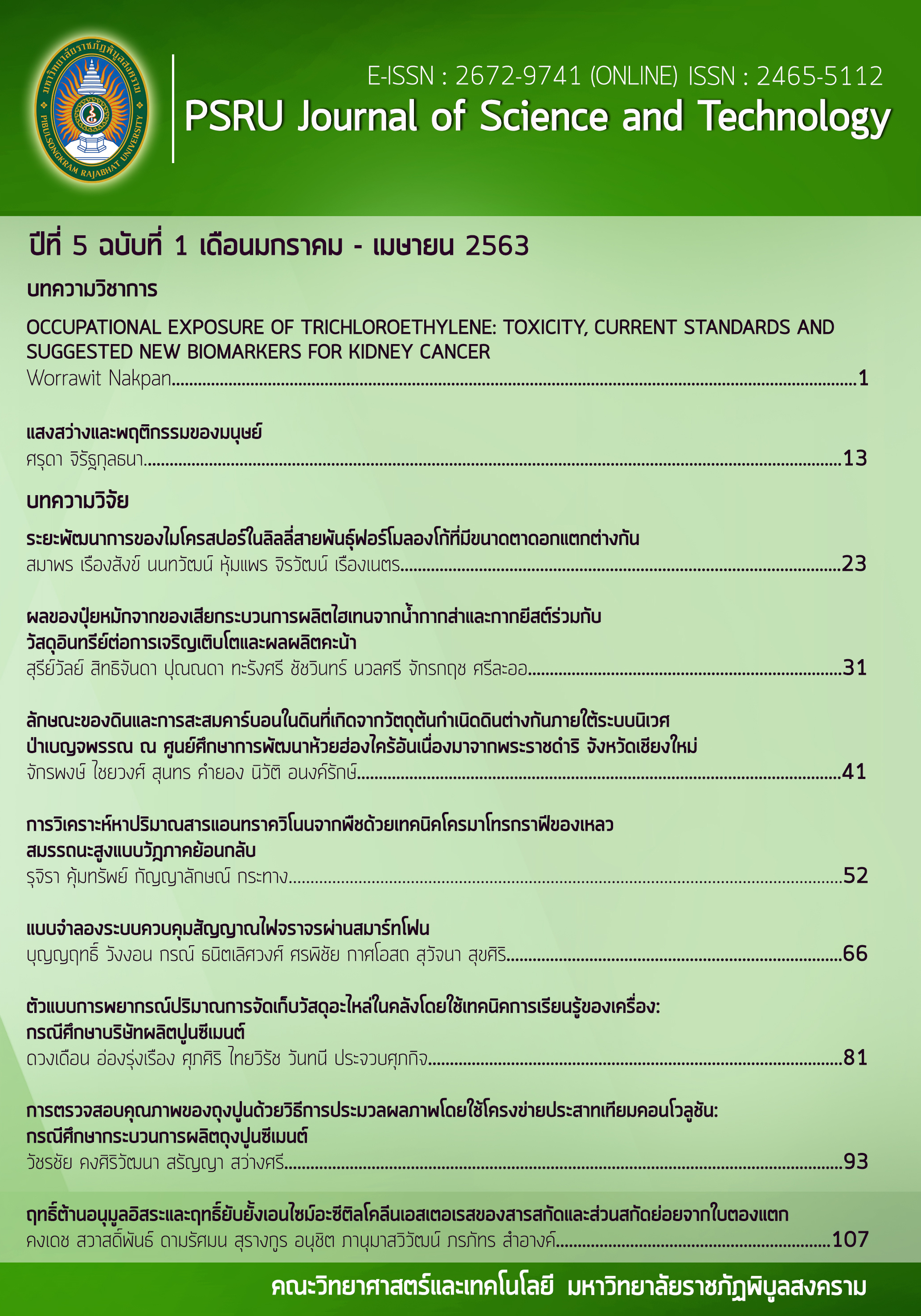MODEL OF TRAFFIC LIGHT CONTROL SYSTEM USING SMART PHONE
Keywords:
Model, Traffic light control system, SmartphoneAbstract
This research presents a model of traffic light control system via smartphone, which simulated at Ban Khlong intersection, Muang district, Phitsanulok province. The data of this study had been collected in 4 periods of time during weekdays. The amount of traffic density was determined to decide the design of traffic light control system that are appropriate for the time period and increase the efficiency of traffic control. The microcontroller raspberry pi was used as processor. A number display monitor was used to indicate times and closed circuit camera was used to monitor number of vehicles. The designs of traffic light control system using smartphone include 2 systems such as automatic system and semiautomatic system. For the automatic system, the traffic light control system was automatically changed for all 4 ranges. The traffic light control system was controlled by traffic police for the semiautomatic system. The both system model was controlled via a smartphone. The results showed that the comparisons during a normal traffic light control system and the traffic light control system using smartphone in the morning at 05:00 – 11:00 am., the efficiency of the traffic light control system using smartphone was higher than the normal traffic light control system 22.05%. In the afternoon at 11:00 – 17:00 pm., the efficiency of the traffic light control system using smartphone was higher than the normal traffic light control system 30.64%. In the evening at 17:00 – 23:00 pm., the efficiency of the traffic light control system using smartphone was higher than the normal traffic light control system 20.43%. At night during 23:00 – 05:00 am., the efficiency of the traffic light control system using smartphone was higher than the normal traffic light control system 26.88%. Finally, the achievement of traffic light control system using smartphone was higher than the normal traffic light control system 22.05% for daylong. A model of traffic light control system using smartphone could be developed for solving traffic problem in the future.
References
ฉัตรมงคล ลิ้มแดงสกุล. (2551). ระบบควบคุมสัญญาณไฟจราจรโดยใช้เทคนิคการประมวลภาพ. (วิทยานิพนธ์ปริญญามหาบัณฑิต). มหาวิทยาลัยนอร์ท, สาขาวิชาเทคโนโลยีสารสนเทศ.
Bell M.G.H., Shield C.M., Anderson J.M. (1995). Assignment in the Integration of Urban Traffic Control and Dynamic Route Guidance, In: Gartner N.H., Improta G. (eds) Urban Traffic Networks. Transportation Analysis. Berlin, Heidelberg: Springer, 39-57.
Bohang L., Xiaoyong Y., Qingbing L. & Shougang H. (2010). An Improved Method for Traffic Control Relying on Close-Loop Control theory. International Asia Conference on Informatics in Control, Automation and Robotics. IEEE, 2010, 48-50.
Chiyakat,C., Visayadamrong C., & Kanchanasuntorn K. (2007). Optimizing Traffic Signal Timing Decisions Using Simulation. Proceedings of the Industrial Engineering Network 2007, October 24-26, 2007, Royal Phuket City Hotel, Phuket, 119-125.
Head K.L., Mirchandani P.B. & Sheppard D. (1996). Hierarchical Framework for Real-Time Traffic Control, Transportation Research Record, 1360, 82-88.
John B. & John A.S. (2001). New Approach for Developing Warrants of Protected Left-turn Phase at Signalized Intersections. Transportation Research part A, 2001, 35(6), 561-574.
Lan R. (1996). UTMC: The Way forward for Urban Traffic Control. Traffic engineering & control, 37(11), 618-623.
Sims A.G. & Dobinson K.W. (1980). The Sydney Coordinated AdaptiveTraffic (SCAT) System Philosophy and Benefits. IEEE Transctions on Vehicular Technology, 29(2), 130-137.
Downloads
Published
How to Cite
Issue
Section
License
กองบรรณาธิการขอสงวนสิทธิ์ในการปรับปรุงแก้ไขตัวอักษรและคำสะกดต่างๆ ที่ไม่ถูกต้อง และต้นฉบับที่ได้รับการตีพิมพ์ในวารสาร PSRU Journal of Science and Technology ถือเป็นกรรมสิทธิ์ของคณะวิทยาศาสตร์และเทคโนโลยี มหาวิทยาลัยราชภัฏพิบูลสงคราม และ
ผลการพิจารณาคัดเลือกบทความตีพิมพ์ในวารสารให้ถือมติของกองบรรณาธิการเป็นที่สิ้นสุด







